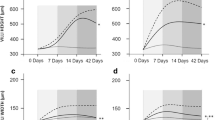Abstract
Functional adaptation of the remnant intestine after extensive resection of small bowel is well documented. The effects of partial resection of large bowel on the remaining colon have not been characterized. Transepithelial potential (VT),tissue resistance (RT),and short-circuit current (I sc) were measuredin vitro across distal colonic tissue of rats three weeks after proximal hemicolectomy with ileotransversotomy and compared to the same parameters measured in the distal colon of control animals. In a second series of experiments, anin vivo perfusion technique was used to measure changes in sodium, potassium, and water transport in distal colon following proximal hemicolectomy. A 2.5-fold increase inV T (P<0.01), a 62% increase inR T (P<0.001), and a 35% increase inI sc (P<0.05) were observed three weeks following hemicolectomy when compared to control animals. A 64% increase in net sodium absorption (P<0.025), no significant change in net potassium transport, and a 115% increase in net water absorption (P<0.01) were demonstrated in hemicolectomized animals when compared to control. It is concluded that in the rat the distal colon is capable of functional adaptation to increase net sodium and water absorption within three weeks after proximal hemicolectomy. The mechanism responsible for this adaptive process has yet to be defined. Our findings may explain the lack of chronic diarrhea in patients undergoing right hemicolectomy.
Similar content being viewed by others
References
Dowling RH, Booth CC: Functional compensation after small-bowel resection in man. Lancet 2:146–147, 1966
Brezin D, Oren BJ: Survival following massive resection of small and large bowel: Water electrolyte and blood volume studies. Gastroenterology 26:895–905, 1954
Thomas JF, Jordan OL: Massive resection of small bowel and total colectomy. Arch Surg 90:781–786, 1965
Weser E, Hernandez MH: Studies of small bowel adaptation after intestinal resection in the rat. Gastroenterology 60:69–75, 1971
Brigh-Asare P, Binder HJ: Stimulation of colonic secretion of water and electrolyte by hydroxy fatty acids. Gastroenterology 64:81–88, 1973
Williamson RCN, Chir M: Intestinal adaptation. Structural functional and cytokinetic changes. N Engl J Med 298:1393–1402, 1978
Obertop H, Nundy S, Malamud D: Onset of cell proliferation in the shortened gut: Rapid hyperplasia after jejunal resection. Gastroenterology 72:267–270, 1977
Hanson WR, Osborne JW, Sharp JG: Compensation by the residual intestine after intestinal resection in the rat. I. Influence of amount of tissue removed. Gastroenterology 73:692–700, 1977
Urban E, Starr PE, Michel AM: Morphologic and functional adaptations of large bowel after small-bowel resection in the rat. Dig Dis Sci 28:265–272, 1983
Cummings JH, James WPT, Wiggins HS: Role of the colon in ileal-resection diarrhea. Lancet 1:344–347, 1973
Mitchell JE, Breuer RI, Zuckerman L, Berlin J, Schilli R, Dunn JK: The colon influences ileal resection diarrhea. Dig Dis Sci 25:33–41, 1980
Williamson RCN, Chir M: Intestinal adaptation. Mechanisms of control. N Engl J Med 298:1444–1450, 1978
Arrambide KA, Santa Ana CA, Schiller LR, Little KH, Santangelo WC, Fordtran JS: Loss of absorptive capacity for sodium chloride as a cause of diarrhea following partial ileal and right colon resection. Dig Dis Sci 34:193–201, 1989
Thompson SM, Suzuki Y, Schultz SG: The electrophysiology of rabbit descending colon. I. Instantaneous transepithelial current-voltage relations and the current-voltage relations of the Na-entry mechanism. J Membr Biol 66:41–54, 1982
Hayslett JP, Halevy J, Pace PE, Binder HJ: Demonstration of net potassium absorption in mammalian colon. Am J Physiol 242:G209-G214, 1982
Binder HJ: Absorption and secretion of water and electrolytes by small and large intestine.In Gastrointestinal Disease, 3rd ed. MH Sleisenger and JS Fordtran (eds). Philadelphia, WB Saunders 1983, p 821
Debonenie JC, Phillips SF: Capacity of the human colon to absorb fluid. Gastroenterology 75:698–703, 1978
Hofmann A: Bile acid malabsorption caused by ileal resection. Arch Intern Med 130:597–605, 1972
Soong CS, Thompson JB, Poley JR, Hess DR: Hydroxy fatty acids in human diarrhea. Gastroenterology 63:748–757, 1972
Gazet JC: The surgical significance of the ileo-caecal junction. Ann R Coll Surg Engl 43:19–22, 1968
Weinstein LD, Shoemaker CP, Hersh T: Enhanced intestinal absorption after small bowel resection in man. Arch Surg 99:560–562, 1969
Sandle GI, Hayslett JP, Binder HJ: Effect of chronic hyper-aldosteronism on the electrophysiology of rat distal colon. Pflugers Arch 401:22–26, 1984
Author information
Authors and Affiliations
Rights and permissions
About this article
Cite this article
Luboshits, J., Goldberg, G., Chubadi, R. et al. Functional adaptation of rat remnant colon after proximal hemicolectomy. Digest Dis Sci 37, 175–178 (1992). https://doi.org/10.1007/BF01308168
Received:
Revised:
Accepted:
Issue Date:
DOI: https://doi.org/10.1007/BF01308168




